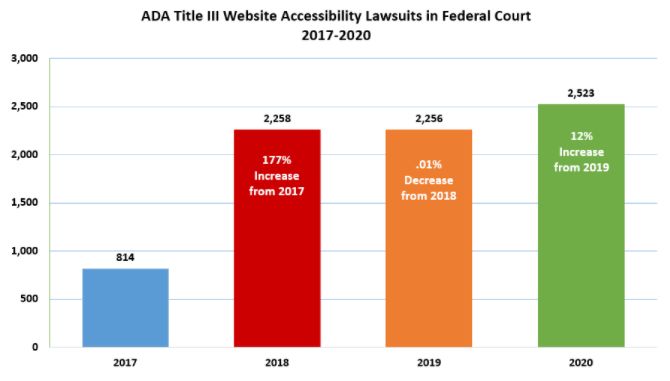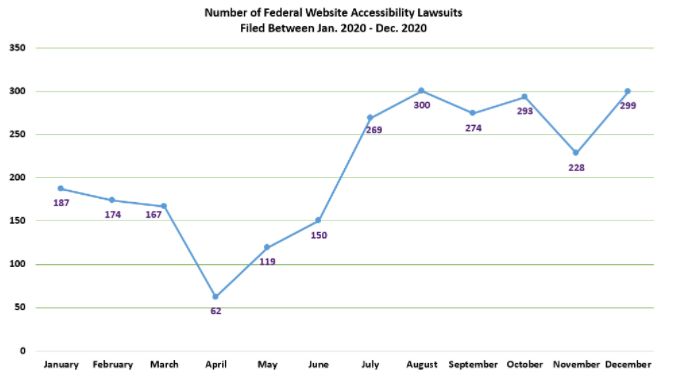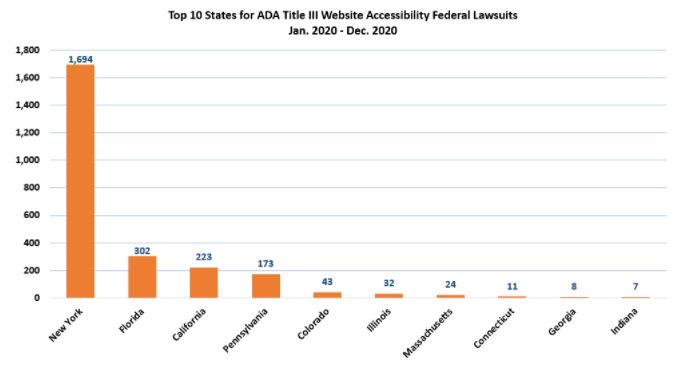- in United States
- with readers working within the Property and Retail & Leisure industries
- within Compliance, Consumer Protection, Government and Public Sector topic(s)
Seyfarth Synopsis: ADA Title III website accessibility lawsuits filed in federal courts in 2020 jumped a surprising 12% over 2019, in spite of a mid-year pandemic dip in filings.
The numbers are in for total website accessibility lawsuit filings in federal courts in 2020, and to our surprise they show a significant increase from 2019. The total number of lawsuits filed in federal courts alleging that plaintiffs with a disability could not use websites because they were not coded to work with assistive technologies like screen readers, or otherwise accessible to them, in 2020 was 2,523-almost 300 more than in 2019. While certainly not akin to the explosive 177% increase in these suits from 2017 to 2018, it is a meaningful increase over the relatively level 2018 and 2019 filing counts.

[Graph: ADA Title III Website Accessibility Lawsuits in Federal Court 2017-2020: 2017: 814; 2018: 2,258 (177% increase from 2017); 2019: 2,256 (.01% decrease from 2018), 2020: 2,523 (12% increase from 2019). *The number of cases that could be identified through a diligent search.]
This is especially remarkable in light of the drop in filings in April 2020 to the lowest number we've seen in quite a while during the height of the pandemic shutdowns across the country, with courts closing, law firms moving to remote work, and lawyers with children adjusting to homeschooling and doing their day jobs. As shown in the chart below, even though filings started out the year lower than 2019 (likely due more to some New York attorneys focusing on Braille gift card lawsuits instead of website accessibility lawsuits and less due to the nascent pandemic), they bottomed out at 62 in April (a third of the 183 filings from the same month in 2019). Filings then slowly increased again, jumping to 300 in August (compare to 270 in 2019), 293 in October (compare to 140 in 2019) and 299 in December (compare to 119 in 2019). We have not yet crunched the Q1 2021 numbers but anecdotally believe those high monthly filing numbers have continued into 2021.

[Graph: Total Number of Website Accessibility Lawsuits Filed by Month (Jan. 2020 - Dec. 2020): Jan. 2020 (187), Feb. 2020 (174), Mar. 2020 (167), Apr. 2020 (62), May 2020 (119), Jun. 2020 (150), Jul. 2020 (269), Aug. 2020 (300), Sep. 2020 (274), Oct. 2020 (293), Nov. 2020 (228), Dec. 2020 (299), *The number of cases that could be identified through a diligent search.]
New York and Florida federal courts continued to be the busiest with 1,694 (up from 1,354 in 2019 and 1,564 in 2018) and 302 (continuing a downward trend of 526 in 2019 and 576 in 2018) lawsuits, respectively, as shown in the chart below. California and Pennsylvania maintained their third and fourth positions, with lawsuits in each of those states almost doubling in 2020 over 2019. Pennsylvania had 173 lawsuits in 2020. The number of California lawsuits continued to jump from 10 in 2018 to 120 in 2019 to 223 in 2020. Colorado moved up from ninth place in 2019 to edge out Illinois for the fifth spot with 43 suits over Illinois's 32 suits (down from 91 lawsuits in 2019). This number does not account for the many demand letters sent out by California firms that never result in lawsuits and lawsuits filed in state courts which are much more difficult to track.

[Graph: Top 10 States for Federal ADA Title III Website Accessibility Lawsuits 2019: NY 1,694, FL 302, CA 223, PA 173, CO 43, IL 32, MA 24, CT 11, GA 8, IN 7. *The number of cases that could be identified through a diligent search.]
This growth in New York federal website accessibility lawsuits is remarkable considering lawsuit filings slowed considerably in the midst of the 2020 pandemic, and some of the most prolific New York plaintiffs' firms turned their attention to Braille gift card cases in late 2019 and early 2020. The New York surge began in 2017 after New York federal judges allowed website accessibility cases to proceed to discovery in lawsuits against Blick Art and Five Guys.
It will be interesting to see if the website accessibility lawsuit numbers will decrease in Florida for 2021 in light of the Eleventh Circuit Court of Appeal's decision in Gil v. Winn Dixie. That decision reduces the number of websites covered by the ADA by holding that only those whose inaccessibility create an intangible barrier to access to the goods, services and facilities of a place of public accommodation state a claim.
Even more remarkable is that these numbers also do not include lawsuits filed alleging the inaccessibility of mobile apps (unless the lawsuit also alleged an inaccessible website). In an unscientific search, we came across 203 lawsuits alleging a violation of the ADA due to inaccessible mobile apps all filed by three attorneys in Florida and New York.
***
About our methodology: Our 2020 numbers are based on searches using keywords of data from the Courthouse News Services. Thus, it is possible that there are some website accessibility cases that were not captured in the searches if their descriptions did not include the keywords. We then review the thousands of entries manually to remove lawsuits that may be about websites but are not about a website's accessibility to a user with a disability. For example, there were a number of lawsuits in 2018-2021 (a very large explosion of such suits in 2021 in California) brought by plaintiffs with mobility disabilities alleging that the reservations websites of hotels did not provide adequate information about the accessibility of hotel facilities. We also removed a number of lawsuits from the 2020 count brought against state and local government entities under Title II of the ADA for having inaccessible websites.
The content of this article is intended to provide a general guide to the subject matter. Specialist advice should be sought about your specific circumstances.



